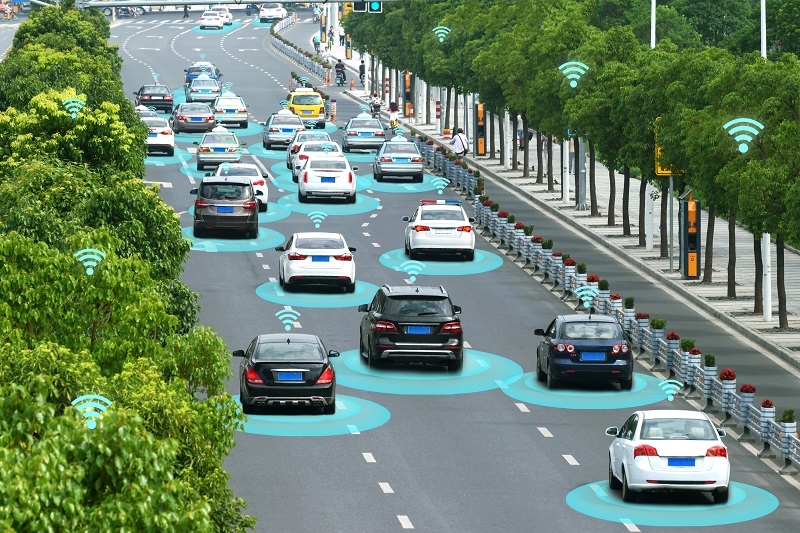
As far as 2025, the USA is going through a massive shift in the automotive industry. With the advent of AI-helped cars, automation of driving, and the creation of smart mobility solutions, driving has become less risky, simpler, and more effective. Due to the focus on automotive trends in 2025 and the future of self-driving cars by the firms, technology is rapidly taking over how transport is conducted. Thus, in the article, we will learn about the AI in cars that dictates this phenomenon and the consequences it will produce on the USA tech mobility in 2025.
Self-driving cars are no longer a thing of the future. The American roads will have them coming into reality in 2025. It is a tendency that is shaping the way human beings travel, commute, and even work.
Self-driving cars are also referred to as autonomous vehicles, which means that the movement of the car is not dependent on human input because the AI controlling it, sensors, and software are superior. These cars are equipped with cameras, radar, GPS, and machine learning, which enable them to understand their surroundings and make decisions, and drive on roads.
Among the available 6 levels of vehicle driving automation, one can hear about the Level 0 (no automation) and Level 5 (fully automated). Many of the cars operating at level 3 or 4 in 2025 are following this aspect, where the cars are driving themselves rather uniquely, and sometimes they need control by human beings.
Leading car manufacturers such as Tesla, Ford, GM, and the newer technology entrants are investing a lot in AI in cars. They are even introducing vehicles with AI-activated functions that include switching lanes automatically, intelligent braking, parking support, and the highway autopilot.
Autonomous vehicles also have various benefits that are shaping the future of travelling and road transport.
AI in automobiles is not just about driving; it’s about creating intelligent systems that improve the entire driving experience. From in-car assistance to traffic predictions, AI is becoming a co-pilot for every driver.
AI in navigation systems helps drivers avoid traffic jams, roadblocks, and construction zones. Real-time updates and machine learning allow GPS systems to suggest better, faster routes.
Cars now come equipped with AI-powered voice assistants. You can ask the car to play music, send texts, adjust the air conditioning, or even call emergency services—all hands-free.
AI monitors the health of the vehicle and warns drivers of potential issues before they happen. This helps avoid breakdowns and saves money.
AI learns your driving style and preferences—seat position, climate control, preferred music, etc.
The future of transportation in America is headed toward full automation. As technology matures, self-driving cars are expected to dominate highways and cities alike.
With the growth of autonomous vehicles, urban planners are reimagining city designs. Roads may become narrower, and parking spaces fewer, as self-driving cars require less space and can drop passengers off before parking themselves elsewhere.
Public buses, taxis, and ride-share services are starting to use autonomous vehicle fleets. This is reducing traffic congestion and offering low-cost transport solutions.
While there is concern over job losses in traditional driving roles, the self-driving car future also opens up new roles—AI engineers, vehicle software testers, traffic data analysts, and mobility service designers.
As AI takes control, questions arise—who is responsible in case of an accident? Companies and regulators are working to update laws and insurance models for the new mobility era.

The concept of mobility in the USA is being redefined. It’s no longer just about owning a car; it’s about smart, connected, and sustainable ways of moving from one place to another.
People are choosing services over ownership. Apps now allow users to plan, book, and pay for all types of transport—bikes, buses, ride-shares, and self-driving taxis—from one place.
AI is playing a major role in optimizing electric vehicle performance. From smart battery management to intelligent charging systems, AI helps extend battery life and reduce energy use.
Cars are becoming more connected than ever before. IoT devices allow vehicles to communicate with each other and with traffic infrastructure—helping prevent collisions and improve flow.
While the benefits are many, the shift to AI-driven cars isn’t without challenges. Some roadblocks still exist in 2025 that need addressing for full adoption.
In 2025, people in the USA are slowly warming up to the idea of self-driving cars. While some are excited, others remain skeptical.
Younger drivers are more open to using autonomous features and trusting AI with their daily commutes.
Elderly drivers benefit from autonomous tech that offers a safer and easier driving experience, although some still prefer manual control.
The US government is playing a big part in shaping the future of AI-driven mobility. From road safety rules to funding innovation, they are helping smooth the transition.
Massive investments are being made in upgrading roads, traffic systems, and 5G networks to support smart vehicles.
Government grants and tax credits are actively encouraging more people to buy EVs and AI-enabled vehicles nationwide.
With regards to cars, there is a huge transformation of the automotive market in the USA in 2025. Trend in autonomous driving in 2025, application of AI in automobile manufacturing, and the increased availability of the self-driving car future, all bode well in the world of smart, safer, and more efficient transportation. The USA tech mobility 2025 provides a backdrop to different forms of transportation so that the interest is not only in machines but also in improvement in how people live, how environments are cleaner, and made accessible to everyone. Not everything is rosy, but at least the future seems bright, and it is driven by AI.
This content was created by AI